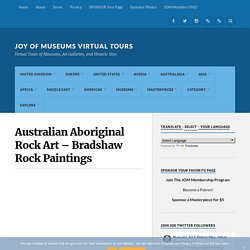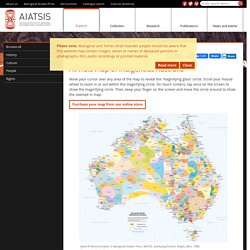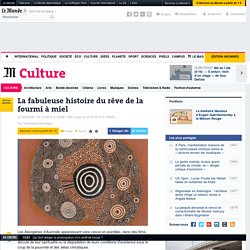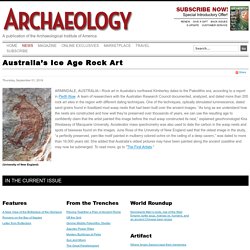

Australian Aboriginal Rock Art - Bradshaw Rock Paintings – Joy of Museums Virtual Tours. Skip to content.

From the desert to the sea : a journey with the Yulparitja - art Aborigène d'Australie — Art Aborigène d'Australie - Aboriginal Signature Estrangin gallery. C’est une première en Europe !

Une rare exposition - rétrospective de tous les artistes Aborigènes majeurs du clan Yulparitja de Bidyadanga. Ils sont tous là, des plus anciens nés en 1928 qui nous ont déjà quittés, à la jeune génération de 1983 qui porte avec un talent incroyable le flambeau. Nous sommes très honorés d’ accueillir en Belgique et particulièrement à la galerie à Bruxelles, l’exposition “From the Desert to the Sea : a Journey with the Yulparitja - at Bidyadanga”. La vie et l’histoire des Aborigènes Yulparitja est bouleversante et remarquable par leur itinéraire de vie et leurs peintures, questionnant notre propre mode de vie. Des réfugiés climatiques au coeur de l’Australie Autour des années 1970, ils furent parmi les premiers réfugiés climatiques de l’histoire de l’Australie contemporaine.
Témoins de l’impact environnemental des mines Un jeune leader inventeur d’un courant artistique. AIATSIS map of Indigenous Australia. Move your cursor over any area of the map to reveal the 'magnifying glass' circle.

Scroll your mouse wheel to zoom in or out within the magnifying circle. On touch screens, tap once on the screen to show the magnifying circle. Then, keep your finger on the screen and move the circle around to show the zoomed in map. Purchase your map from our online store For thousands of years, the original inhabitants of Australia, Aboriginal and Torres Strait Islander peoples occupied the lands with very different boundaries than today, centred on intimate cultural relationships with the land and sea. “It’s my fathers land, my grandfather’s land, my grandmothers land. The map is an attempt to represent all the language, tribal or nation groups of the Indigenous peoples of Australia. A genomic history of Aboriginal Australia.
Tolarno Galleries. On 'Carpentaria', by Alexis Wright - Griffith Review. I FIRST READ the fiction of Alexis Wright when I was writing a thesis on transgenerational trauma for my doctorate at Western Sydney University.

I was exploring the ways in which literature testifies to transmissions of psychic trauma, which, in Unclaimed Experience (Johns Hopkins University Press, 1996), Cathy Caruth defines as the impact of an unassimilated event or experience that makes its presence known belatedly and often illogically. In Carpentaria, Wright’s second novel, I found a prime example of such testimony: a fierce epic that both honours Indigenous sovereignty and culture and attests to the ravages wrought by colonisation. Set in the fictional coastal town of Desperance, on the Gulf of Carpentaria in north-west Queensland, the novel centres on the infighting between local Aboriginal communities, and the greater challenge that befalls the region when a multinational mining corporation sets up on sacred land. References Wright, A 1997, The Grog War, Magabala Books, Broome. Burrup Peninsula Aboriginal rock engravings in the Pilbara - Australia's North West. La fabuleuse histoire du rêve de la fourmi à miel.
LE MONDE | • Mis à jour le | Par Véronique Mortaigne Les Aborigènes d'Australie apparaissent sans cesse en pointillés, dans des films, des galeries d'art ou des forums de discussion sur les peuples premiers où l'on discute de leur spiritualité ou la dégradation de leurs conditions d'existence sous le coup de la pauvreté et des aléas climatiques.

Vous pouvez encore ajouter à cela l'engouement des amateurs d'exotisme et de respiration circulaire pour le didgeridoo, long tube d'eucalyptus, au son profond et vibrant, creusé à l'origine par les termites. Mais pour étrange qu'il y paraisse, l'exposition du Musée du quai Branly est la première manifestation d'envergure consacrée en France à l'art des Aborigènes. "Aux sources de la peinture aborigène, Australie-Tjukurrtjanu", présentée à Paris au Musée du quai Branly jusqu'au 20 janvier 2013, a été conçue avec la National Gallery of Victoria et le Museum Victoria de Melbourne.
Australia’s Ice Age Rock Art. (University of New England) ARMINDALE, AUSTRALIA—Rock art in Australia’s northwest Kimberley dates to the Paleolithic era, according to a report in {*style:<i>*}{*style:<a href=' Now{*style:</a>*}{*style:</i>*}.

A team of researchers with the Australian Research Council documented, analyzed, and dated more than 200 rock art sites in the region with different dating techniques. One of the techniques, optically stimulated luminescence, dated sand grains found in fossilized mud wasp nests that had been built over the ancient images. “As long as we understand how the nests are constructed and how well they’re preserved over thousands of years, we can use the resulting age to confidently claim that the artist painted this image before the mud wasp constructed its nest,” explained geochronologist Kira Westaway of Macquarie University. Accelerator mass spectrometry was also used to date the carbon in the wasp nests and spots of beeswax found on the images.